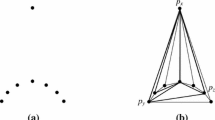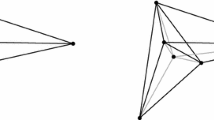Abstract
The minimum network problem (Steiner tree problem) in space is much harder than the one in the Euclidean plane. The Steiner tree problem for four points in the plane has been well studied. In contrast, very few results are known on this simple Steiner problem in 3D-space. In the first part of this paper we analyze the difficulties of the Steiner problem in space. From this analysis we introduce a new concept — Simpson intersections, and derive a system of iteration formulae for computing Simpson intersections. Using Simpson intersections the Steiner points can be determined by solving quadratic equations. As well this new computational method makes it easy to check the impossibility of computing Steiner trees on 4-point sets by radicals. At the end of the first part we consider some special cases (planar and symmetric 3D-cases) that can be solved by radicals. The Steiner ratio problem is to find the minimum ratio of the length of a Steiner minimal tree to the length of a minimal spanning tree. This ratio problem in the Euclidean plane was solved by D. Z. Du and F. K. Hwang in 1990, but the problem in 3D-space is still open. In 1995 W.D. Smith and J.M. Smith conjectured that the Steiner ratio for 4-point sets in 3D-space is achieved by regular tetrahedra. In the second part of this paper, using the variational method, we give a proof of this conjecture.
Similar content being viewed by others
References
Cieslik, D.: Steiner Minimal Trees, Kluwer Acad. Publ., Dordrecht, 1998.
Courant, R. and Robbins, H.: What is Mathematics, Oxford Univ. Press, New York, 1941.
Du, D. Z., and Hwang, F. K.: A proof of Gilbert and Pollak's conjecture on the Steiner ratio, Algorithmica, 7 (1992), 121–135.
Du, D. Z., Hwang, F. K., Song, G. D. and Ting, G. Y.: Steiner minimal trees for four points, Discrete Comput. Geom. 2 (1987), 401–414.
Du, D. Z., Yao, E. Y. and Hwang, F. K.: A short proof of a result of Pollak on Steiner minimal trees, J. Combin. Theory Ser. A, 32 (1982), 396–400.
Du, X. F., Du, D. Z., Gao, B. and Lixue, Q.: A simple proof for a result of Ollerenshaw on Steiner trees, In: Advances in Optimization and Approximation, Nonconvex Optim. Appl. 1, Kluwer Acad. Publ., Dordrecht, 1994, pp. 68–71.
Hwang, F. K.: A linear time algorithm for full Steiner trees, Oper. Res. Lett. 5 (1986), 235–237.
Hwang, F. K. and Weng, J.F.: Hexagonal coordinate systems and Steiner minimal trees, Discrete Math. 62 (1986), 49–57.
Hwang, F. K., Richard, D. S. and Winter, P.: The Steiner Tree Problem, North-Holland, Amsterdam, 1992.
Kuhn, H. W.: 'steiner's' problem revisited, In: G. B. Dantzig and B. C. Eaves (eds), Studies in Optimization, Math. Assoc. Amer., Washington, 1974, pp. 52–70.
Mehlhos, St.: Simple counter examples for the unsolvability of the Fermat-and Steiner- Weber-problem by compass and ruler, Contrib. Algebra Geom. 41 (2000), 151–158.
Melzak, Z. A.: On the Steiner problem, Canad. Math. Bull. 4 (1961), 143–148.
Ollerenshaw, K.: Minimum networks linking four points in a plane, Inst. Math. Appl. 15 (1978), 208–211.
Pollak, H. O.: Some results on the Steiner problem, J. Combin. Theory Ser. A 24 (1978), 278–295.
Rubinstein, J. H. and Thomas, D. A.: A variational approach to the Steiner network problem, Ann. Oper. Res. 33 (1991), 481–499.
Rubinstein, J. H. and Thomas, D. A.: The Steiner ratio conjecture for six points, J. Combin. Theory Ser. A 58 (1991), 54–77.
Rubinstein, J. H. and Thomas, D. A.: The Steiner ratio conjecture for cocircular points, J. Discrete Comput. Geom. 7 (1992), pp. 77–86.
Smith, W. D.: How to find Steiner minimal trees in Euclidean d-space, Algorithmica 7 (1992), 137–177.
Smith, W. D. and Smith, J. M.: On the Steiner ratio in 3D-space, J. Combin. Theory Ser. A 69 (1995), 301–332.
Weng, J. F.: Generalized Steiner problem and hexagonal coordinate system (in Chinese), Acta Math. Appl. Sinica 8 (1985), 383–397.
Weng, J. F.: Symmetrization theorem of full Steiner trees, J. Combin. Theory Ser. A 66 (1994), 185–191.
Weng, J. F.: Variational approach and Steiner minimal trees on four points, DiscreteMath. 132 (1994), 349–362.
Author information
Authors and Affiliations
Rights and permissions
About this article
Cite this article
Rubinstein, J.H., Thomas, D.A. & Weng, J. Minimum Networks for Four Points in Space. Geometriae Dedicata 93, 57–70 (2002). https://doi.org/10.1023/A:1020389712969
Issue Date:
DOI: https://doi.org/10.1023/A:1020389712969




